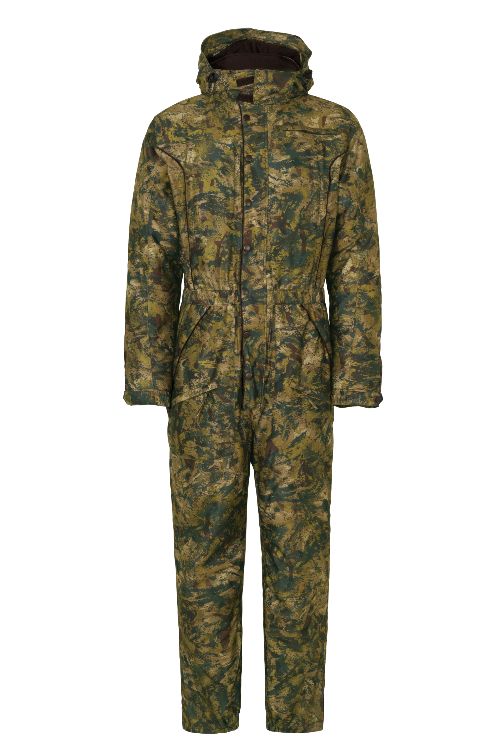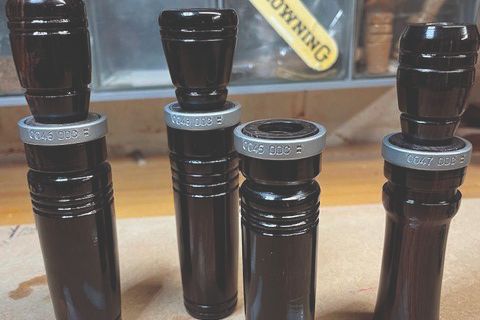
Seeland Outthere camo one-piece
Anticipating a long, cold wait on a windy shore or bleak estuary? Keep those freezing draughts out and your own body heat in with this cosy one-piece from Seeland. The Outthere camo one-piece features a windproof and waterproof Seetex two-layer membrane to protect you from sudden downpours and strong gusts, with a super-cosy 200g lining for added insulation when inactive for long periods of time. The outer is made from a soft, low-noise tricot fabric, so this winter warmer will also come in handy for keeping frostbite at bay during those early mornings spent waiting in the high seat. Other useful features include multiple zip pockets, a racing back for freedom of movement when shooting, and long, two-way zips on the front of each leg for easy on/off when wearing boots. Available in sizes 48-64 in InVis camo. £359.99 seeland.com

Handmade duck and goose calls
Call and they will come! That’s the tagline of DDC, a small, independent company run by Dave Fox. Dave is a lifelong wildfowler who lives out his passion on the Ouse Washes and foreshore, and makes the most beautiful duck and goose calls out of wood and acrylic.
All the calls are hand-turned by the man himself, and each is supplied with a unique number band, a spare reed and cork, and a bag and presentation box. Bespoke colour designs, no matter how wacky, can be catered for; what a brilliant gift idea for someone who loves duck and goose shooting!
DDC calls are available from Whittalsea Guns, Cambridgeshire, and Philip Webster Gunsmiths, Norfolk.
Expert advice
Ben Palfreyman from the Sporting Shooter team joined our expert Alan Jarrett on the Kent saltmarsh to find out what essentials he recommends keeping in your kit bag
- Wading stick: Always have a good stick with you. Alan uses an old broom handle as it’s long enough to push yourself out of sticky situations in the watery mid-creek mud. I found a straight 4' branch that had fallen from a tree during the storms, but you can also buy nice wading sticks with weighted bottoms from the likes of Bisley.
- Decoys: Wildfowling is all about the practicalities, and this includes your decoy set-up. If the water is going to be rough, make sure you have decoys with solid gills or they could fill up with water and flip over.
- Decoy pegs: Go for white ones – they are much easier to see in the dark at the end of the flight!
- Decoy placement: Alan advises that if you are able to walk out and place your decoys, use a peg, fish line and anchor to keep each in place. If you are throwing the decoys out, you’ll need a line and weight, so they stay in position and you can pull them back – but this set-up adds weight and every pound adds up!
- Gun: Alan favours gas-operated semi-autos as they absorb recoil so effectively, which is particularly appreciated when shooting those bigger loads. Also, going for one with a 3½" chamber means you can shoot light and heavy loads through it if you go out on a variety of quarry – you’ll need this for those 42g of steel!
- Camo: If in doubt, choose camo, whether that be your hat, your bag or your coat! And this includes your gun if you have the option.
- Outerwear: Make sure all your outerwear is waterproof, even on those unlikely (but very welcome) dry, warm days, or you’ll end up like me – sitting on your gloves. Even when on terra firma, the ground will still be wet. Waterproof trousers (such as the Seeland Buckthorns) are vital – and if you find these uncomfortable under your thigh waders, you can do as Alan does and cut them off at the knees.
- Hide: Think carefully about your hide colour. This year’s autumn has been so mild that the landscape was remarkably green when we went out early December – so always make sure you have the right hide for today, not for what worked well last year, or five years ago!
- Cartridge belt: Ditch the cartridge bag for a cartridge belt. It’s easier to carry, less to clean at the end of the day – and unless you’re in the habit of firing at fowl beyond your limits, you won’t need many loads anyway.